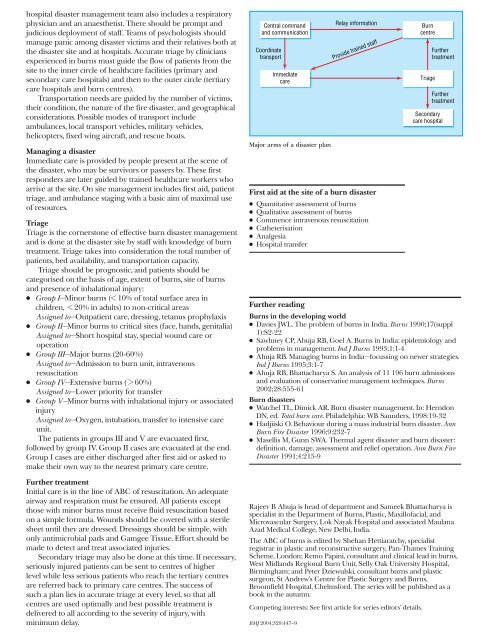ABC of Burns
Create successful ePaper yourself
Turn your PDF publications into a flip-book with our unique Google optimized e-Paper software.
hospital disaster management team also includes a respiratory<br />
physician and an anaesthetist. There should be prompt and<br />
judicious deployment <strong>of</strong> staff. Teams <strong>of</strong> psychologists should<br />
manage panic among disaster victims and their relatives both at<br />
the disaster site and at hospitals. Accurate triage by clinicians<br />
experienced in burns must guide the flow <strong>of</strong> patients from the<br />
site to the inner circle <strong>of</strong> healthcare facilities (primary and<br />
secondary care hospitals) and then to the outer circle (tertiary<br />
care hospitals and burn centres).<br />
Transportation needs are guided by the number <strong>of</strong> victims,<br />
their condition, the nature <strong>of</strong> the fire disaster, and geographical<br />
considerations. Possible modes <strong>of</strong> transport include<br />
ambulances, local transport vehicles, military vehicles,<br />
helicopters, fixed wing aircraft, and rescue boats.<br />
Managing a disaster<br />
Immediate care is provided by people present at the scene <strong>of</strong><br />
the disaster, who may be survivors or passers by. These first<br />
responders are later guided by trained healthcare workers who<br />
arrive at the site. On site management includes first aid, patient<br />
triage, and ambulance staging with a basic aim <strong>of</strong> maximal use<br />
<strong>of</strong> resources.<br />
Triage<br />
Triage is the cornerstone <strong>of</strong> effective burn disaster management<br />
and is done at the disaster site by staff with knowledge <strong>of</strong> burn<br />
treatment. Triage takes into consideration the total number <strong>of</strong><br />
patients, bed availability, and transportation capacity.<br />
Triage should be prognostic, and patients should be<br />
categorised on the basis <strong>of</strong> age, extent <strong>of</strong> burns, site <strong>of</strong> burns<br />
and presence <strong>of</strong> inhalational injury:<br />
x Group I—Minor burns (< 10% <strong>of</strong> total surface area in<br />
children, < 20% in adults) to non-critical areas<br />
Assigned to—Outpatient care, dressing, tetanus prophylaxis<br />
x Group II—Minor burns to critical sites (face, hands, genitalia)<br />
Assigned to—Short hospital stay, special wound care or<br />
operation<br />
x Group III—Major burns (20-60%)<br />
Assigned to—Admission to burn unit, intravenous<br />
resuscitation<br />
x Group IV—Extensive burns ( > 60%)<br />
Assigned to—Lower priority for transfer<br />
x Group V—Minor burns with inhalational injury or associated<br />
injury<br />
Assigned to—Oxygen, intubation, transfer to intensive care<br />
unit.<br />
The patients in groups III and V are evacuated first,<br />
followed by group IV. Group II cases are evacuated at the end.<br />
Group I cases are either discharged after first aid or asked to<br />
make their own way to the nearest primary care centre.<br />
Further treatment<br />
Initial care is in the line <strong>of</strong> <strong>ABC</strong> <strong>of</strong> resuscitation. An adequate<br />
airway and respiration must be ensured. All patients except<br />
those with minor burns must receive fluid resuscitation based<br />
on a simple formula. Wounds should be covered with a sterile<br />
sheet until they are dressed. Dressings should be simple, with<br />
only antimicrobial pads and Gamgee Tissue. Effort should be<br />
made to detect and treat associated injuries.<br />
Secondary triage may also be done at this time. If necessary,<br />
seriously injured patients can be sent to centres <strong>of</strong> higher<br />
level while less serious patients who reach the tertiary centres<br />
are referred back to primary care centres. The success <strong>of</strong><br />
such a plan lies in accurate triage at every level, so that all<br />
centres are used optimally and best possible treatment is<br />
delivered to all according to the severity <strong>of</strong> injury, with<br />
minimum delay.<br />
Central command<br />
and communication<br />
Coordinate<br />
transport<br />
Immediate<br />
care<br />
Major arms <strong>of</strong> a disaster plan<br />
Relay information<br />
Provide trained staff<br />
First aid at the site <strong>of</strong> a burn disaster<br />
x Quantitative assessment <strong>of</strong> burns<br />
x Qualitative assessment <strong>of</strong> burns<br />
x Commence intravenous resuscitation<br />
x Catheterisation<br />
x Analgesia<br />
x Hospital transfer<br />
Further reading<br />
Burn<br />
centre<br />
Triage<br />
Further<br />
treatment<br />
Further<br />
treatment<br />
Secondary<br />
care hospital<br />
<strong>Burns</strong> in the developing world<br />
x Davies JWL. The problem <strong>of</strong> burns in India. <strong>Burns</strong> 1990;17(suppl<br />
1):S2-22<br />
x Sawhney CP, Ahuja RB, Goel A. <strong>Burns</strong> in India: epidemiology and<br />
problems in management. Ind J <strong>Burns</strong> 1993;1:1-4<br />
x Ahuja RB. Managing burns in India—focussing on newer strategies.<br />
Ind J <strong>Burns</strong> 1995;3:1-7<br />
x Ahuja RB, Bhattacharya S. An analysis <strong>of</strong> 11 196 burn admissions<br />
and evaluation <strong>of</strong> conservative management techniques. <strong>Burns</strong><br />
2002;28:555-61<br />
Burn disasters<br />
x Watchel TL, Dimick AR. Burn disaster management. In: Herndon<br />
DN, ed. Total burn care. Philadelphia: WB Saunders, 1998:19-32<br />
x Hadjiiski O. Behaviour during a mass industrial burn disaster. Ann<br />
Burn Fire Disaster 1996;9:232-7<br />
x Masellis M, Gunn SWA. Thermal agent disaster and burn disaster:<br />
definition, damage, assessment and relief operation. Ann Burn Fire<br />
Disaster 1991;4:215-9<br />
Rajeev B Ahuja is head <strong>of</strong> department and Sameek Bhattacharya is<br />
specialist in the Department <strong>of</strong> <strong>Burns</strong>, Plastic, Maxill<strong>of</strong>acial, and<br />
Microvascular Surgery, Lok Nayak Hospital and associated Maulana<br />
Azad Medical College, New Delhi, India.<br />
The <strong>ABC</strong> <strong>of</strong> burns is edited by Shehan Hettiaratchy, specialist<br />
registrar in plastic and reconstructive surgery, Pan-Thames Training<br />
Scheme, London; Remo Papini, consultant and clinical lead in burns,<br />
West Midlands Regional Burn Unit, Selly Oak University Hospital,<br />
Birmingham; and Peter Dziewulski, consultant burns and plastic<br />
surgeon, St Andrew’s Centre for Plastic Surgery and <strong>Burns</strong>,<br />
Broomfield Hospital, Chelmsford. The series will be published as a<br />
book in the autumn.<br />
Competing interests: See first article for series editors’ details.<br />
BMJ 2004;329:447–9



